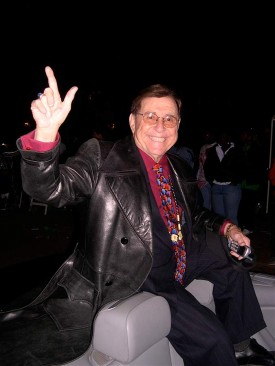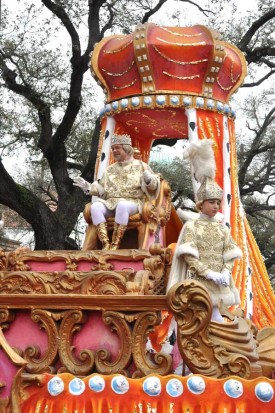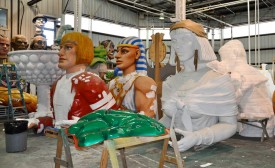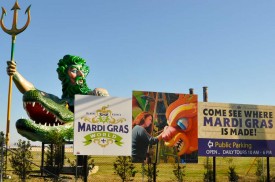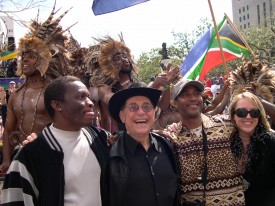After turning down a job offer from a fellow master of fantasy, Walt Disney, Blaine Kern built his own kingdom of make-believe in the city of Mardi Gras dreams — becoming perhaps the world’s largest builder of parade floats. In New Orleans, he is known as Mr. Mardi Gras, a moniker he copyrighted years ago. But this and other acts of brazen self-promotion are easily forgiven. For if modern Mardi Gras has a father, it’s none other than Blaine Kern.
Mr. Mardi Gras
Blaine Kern
From humble beginnings after World War II, he became the city’s dominant float builder and a key player in the formation of new Mardi Gras krewes — transforming what was once essentially a seasonal ritual for locals into an internationally recognized, mass-entertainment spectacle that has witnessed a huge expansion in the annual number or parades, media coverage, tourist interest and economic impact.
The highlight of the 1998 Carnival parade season in New Orleans was the debut of the Leviathan, a 120-foot “superfloat” that rides on a bed of smoke and has some 54,000 points of multicolored fiber-optic light, which shimmer like beads of water dripping from the biblical sea dragon’s scales.
Spectators were blown away. “Instead of just yelling ‘Throw me something,’ ” marvels Blaine Kern, whose company built the float for the Krewe of Orpheus, “they started clapping and cheering—clapping for the float, which was a departure.”
To be sure, Kern has always been an innovator. Back in the early 1950s, when parades offered only dim echoes of the feats of artistic splendor that had characterized the Golden Age of New Orleans Carnival in the late 1800s and early 1900s, he turned out floats featuring storybook characters whose heads turned and whose eyes moved. Then in 1968, his huge, Disneyesque floats for the newly minted Krewe of Bacchus marked the beginning of an era in which Carnival festivities entered the realm of popular entertainment.
Today, Kern Studios claims to be the world’s biggest builder of parade floats. Over the years its rolling creations have delighted celebrants in such far-flung places as Havana, Cuba and Cannes, France. In New Orleans, Kern is known as Mr. Mardi Gras, a moniker he trademarked years ago. But this and other acts of brazen self-promotion are easily forgiven. For if modern Mardi Gras has a father, it’s none other than Blaine Kern.
Long before he began transforming Mardi Gras fantasies into reality, Kern had an active imagination. As a young boy growing up a short distance from where he’d later build his fantastical realm of make-believe—in Algiers, across the river from New Orleans—he fell under the influence of four old-maid schoolteachers who had helped raise his mother. They regaled him with stories of the Civil War era, and had him read H.G. Wells, Sir Arthur Conan Doyle, Edgar Rice Buroughs and Jules Verne.
“I was always looking out the window, daydreaming,” Kern recalls. “Reading books and drawing pictures. Always in trouble in school.” Kern’s father, Roy, was a fine artist by trade who painted signs during the Depression to put food on his family’s table. Roy Kern helped start the Krewe of Alla (for Algiers, La.) in 1932, building a single float which led the group’s first procession. Four year later, Blaine helped his father convert six old trash wagons into covered wagons for the Krewe of Choctaw’s first parade.
Krewe of Orpheus Leviathan
Floats from Blaine Kern Artists range from traditional, small-scale affairs with sculpted thematic elements built atop basic flatbed trailers to elaborate, multi-section extravaganzas with technologically advanced sound and lighting systems and heavy-duty steel chassis with articulated rear axles for tracking around corners.
At age 14, Kern went to work painting ships’ names on smokestacks and doing other brushwork in the Algiers yards. After a stint in the Army, when he offered to paint a mural in a hospital to help pay his mother’s medical bills, Kern got a break. One of the hospital’s doctors was the captain of Krewe of Alla. He so admired Kern’s mural, which depicted the history of medicine, that he asked the young man to design and build 11 floats for the club’s 1946 parade. Kern was off and running.
His Alla floats got the attention of wealthy businessman and socialite Darwin Fenner, the son of the Fenner in Merrill Lynch, Pierce, Fenner & Smith. Captain of the prestigious Rex organization, Fenner underwrote trips to Europe for Kern to study Carnival traditions in Cologne, Frankfurt, Nice, Viareggio and Valencia. “He was like a daddy to me,” says Kern.
Back in New Orleans, Kern spotted a weakness in the parades staged by the most prominent krewes. Their floats had become predictable and somewhat drab—typically resembling large, gussied-up baby carriages—and relied heavily on figures from ancient mythology to depict allegorical themes. But Kern’s oversized, papier mache creations for Rex in the early 1950s were fanciful, if not outlandish. Orders from other krewes came pouring in.
Rex “king” float
Kern’s association with the Rex Organization, whose monarch (also named Rex) is a totemic figurehead for the entire Mardi Gras celebration, dates back to 1950.
In 1959, Kern met a fellow master of fantasy, Walt Disney. Visiting Mardi Gras, Disney was taken with one of Kern’s more inspired creations: an18-foot-tall gorilla, with five men inside, that walked and made facial expressions. Disney put the gorilla in his Wonderful World of Color TV show and offered Kern a job in Los Angeles. But Fenner convinced the enterprising artisan to say no to Walt.
According to Kern, “He said, ‘Son, let me tell you: You stay here in New Orleans, you’re gonna be a big fish in a little pond. You go out there, you’re gonna be a small fish in a big pond.’ He says, ‘Your fortune will be here in the future. Mardi Gras is democratizing, it’s opening up to everybody.’ ”
In the late 1960s, Kern and other entrepreneurs not born to the upper crust came together in an effort to promote tourism and broaden the avenues of participation in Carnival. They formed the krewes of Endymion, in 1967, and Bacchus, in 1968. You needed no social credentials to join. Bacchus took to the streets with the biggest, most extravagant floats ever, and had a celebrity, Danny Kaye, as its first king (a tradition that continues to this day). “Modern Mardi Gras dates from the first run of Bacchus, there’s no doubt about that,” Mel Leavitt, the late New Orleans newscaster and author, observed in a 1995 interview.
The insular Carnival aristocracy—comprised of old-line krewes such as Comus, Momus and Proteus—was not amused at the prospect of being upstaged by newcomers who seemed more interested in showbiz than tradition. “Some people wanted to hit me on the head” for opening up the festivities to the non-elite, recalls Kern. They pressured the owners of the tractors used to pull floats not to rent to Bacchus, prompting Kern and the upstarts to buy their own fleet of vehicles.
Overcoming that obstacle gave Kern another idea: Why not create floats and buy tractors to rent to others who wanted to parade?
The Prop Shop at Blaine Kern’s Mardi Gras World
The company’s huge inventory of props — depicting a multitude of themes and famous characters from history, literature and myth — are constantly being recycled and refurbished for use on Mardi Gras floats as well as for sale and rental to themed attractions and event producers.
Kern’s rental business took off immediately. Nowadays, his rental fleet of 40-odd floats will typically appear in nine Carnival parades in metropolitan New Orleans. Built with detachable features, or “props,” they can be adapted easily to any number of themes.
When Kern began building floats in the 1940s, there were just a dozen parading kerews in the New Orleans area. Today there are upwards of 50 and Kern supplies floats to about half of them. His biggest clients are Bacchus, Endymion, Orpheus and Rex. He also builds floats for the popular Halloween and Mardi Gras parades put on by the Universal Studios theme park in Orlando, Fla., as well as for Mardi Gras celebrations in places like Shreveport, La. and Galveston, Tex.
In and around New Orleans, Kern owns and leases warehouses, or “dens,” totaling around 300,000 square feet, and has adjacent property used for “staging areas,” where floats are hooked up to tractors and prepped for parades. Kern also maintains storage facilities in Orlando, Galveston; Valencia, Spain and Antibes, France, among other locations.
Kern’s showcase den along the Mississippi River in New Orleans, Mardi Gras World, has become a major tourist attraction where visitors can watch artists, sculptors, electricians and welders at work. In the Prop Shop, fiberglass float figures from Mardi Gras’ past are made over to meet the thematic requirements of new parades. Thus, Madonna, with her hair tied in a top knot, becomes Barbara Eden’s character in I Dream of Genie. Or John Wayne, celluoid hero of the Old West, becomes Freddy Krueger, king of Hollywood slasher films.
Sign beckoning visitors to Kern’s fantasy factory
The Old Man River and alligator sculptures were originally part of Kern’s fondly remembered Bridge Gate, one of the two main entrances to the 1984 World’s Fair in New Orleans.
The Kerns also rent out Mardi Gras World for parties. Son Brian Kern, 34, runs the business, which includes a well-stocked gift shop. In 1998, over 150,000 tourists and party goers visited Mardi Gras World. Another Kern business sells beads, doubloons and other items to Carnival krewes and other wholesale customers.
The Kern empire is very much a family affair. Son Barry, 36, founded Kern Sculpture Co., which builds customized props and decor pieces for hotels, theme parks, casinos and emporiums. (The Walt Disney Co. is one of its biggest customers.) Blaine Kern Jr., 43, owns Mardi Gras Productions, which provices scenery, lighting and sound for events involving New Orleans’ thriving hotel and convention trade. Mardi Gras Productions and Blaine Sr.’s company, which together share a large inventory of props and decorative fixtures, often cooperate on projects. Blaine Jr.’s right hand is his eldest sister, known as T.K., 44.
Blaine Sr.’s ultimate fantasy is to develop 40 acres of riverfront property he controls in Algiers. A centerpiece was to have been a 622-foot heavy cruiser that had been converted into an aircraft carrier. The Spanish navy had acquired the vessel from the U.S. after World War II.
In 1988, Kern formed a foundation to bring the vessel to New Orleans and convert it into a naval museum that would be moored along the levee in Algiers. The project included plans to resurrect an ariel line of cable cars spanning the Mississippi River. Kern had built the line to connect the 1984 World’s Fair in New Orleans to Mardi Gras World, but it was later torn down.
Blaine Kern with Zulu warriors and representatives from South Africa, Mardi Gras 2006
Kern arranged to bring the Zulus to New Orleans to perform in the Zulu Social Aid and Pleasure Club parade on first the Mardi Gras after Hurricane Katrina, as a morale booster and gift to the club, whose members suffered severe losses from the storm and had to dig deep to pull off their comeback parade.
The Spaniards sold the carrier to the foundation for 1 peseta (about five cents). But then the foundation spent roughly $2.5 million—$2 million of which came via a grant from the U.S. government—to sail her from Valencia to New Orleans and start fixing her up. However, rennovation costs got out of hand; and when promised contributions failed to materialize, the foundation went bust.
All the while Kern, anticipating the Louisiana legislature’s approval of riverboat gambling, thought the carrier’s huge hanger deck would make a casino. But then the state’s pols decreed that all gambling boats had to look like Mississippi riverboats. Ultimately, the vessel had to be sold for scrap. “I don’t know how many hundreds of thousands it cost me,” says Kern of the debacle.
Not that Kern, a self-described “ninth-generation Algierine,” has given up on the idea of turning Algiers into what he calls “new New Orleans.” With support from the Louisiana Music Commission and other sources, he has raised $700,000 to build a Jazz Walk of Fame along the levee in Algiers. Sixty-three exhibit areas are being constructed at regular intervals along a 3,500-foot-long paved promenade; each will have a French Quarter-style street light with a sign bearing the name of a Louisiana jazz legend, an ornamental iron bench, and a push-button-activated system to provide a sound bite of the artist’s music and a brief explanation of his or her contribution to jazz.
Despite having undergone heart-bypass surgery in early 1998, Kern, 72, has no plans to retire. As captain of Alla, he says that he’ll still don a froufrou feather outfit for the club’s parade and “dance a very improbable dance”—thus inspiring his cohorts to think: “Well, if that old son of a bitch can do it, I can too.”
MardiGrasTraditions.com

